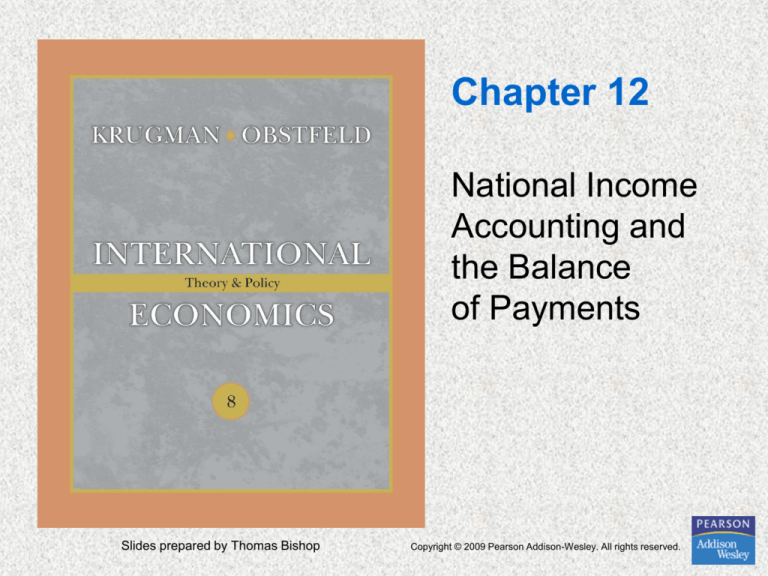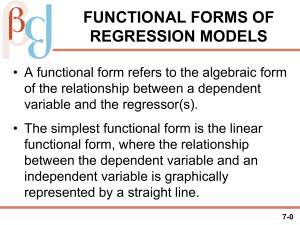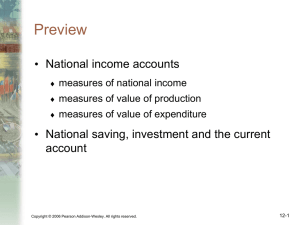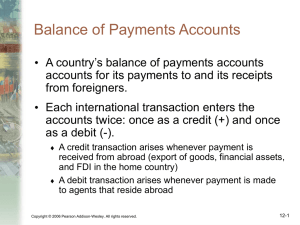
Chapter 12
National Income
Accounting and
the Balance
of Payments
Slides prepared by Thomas Bishop
Copyright © 2009 Pearson Addison-Wesley. All rights reserved.
Preview
• National income accounts
measures of national income
measures of value of production
measures of value of expenditure
• National saving, investment, and the current
account
• Balance of payments accounts
Copyright © 2009 Pearson Addison-Wesley. All rights reserved.
12-2
National Income Accounts
• Records the value of national income that
results from production and expenditure.
Producers earn income from buyers who spend
money on goods and services.
The amount of expenditure by buyers =
the amount of income for sellers =
the value of production.
National income is often defined to be the income
earned by a nation’s factors of production.
Copyright © 2009 Pearson Addison-Wesley. All rights reserved.
12-3
National Income Accounts: GNP
• Gross national product (GNP) is the value
of all final goods and services produced by a
nation’s factors of production in a given
time period.
What are factors of production? Factors that are
used to produce goods and services: workers
(labor services), physical capital (like buildings and
equipment), natural resources and others.
The value of final goods and services produced by
US-owned factors of production are counted as US
GNP.
Copyright © 2009 Pearson Addison-Wesley. All rights reserved.
12-4
National Income Accounts: GNP (cont.)
•
GNP is calculated by adding the value of
expenditure on final goods and services produced.
•
There are 4 types of expenditure:
1. Consumption: expenditure by domestic consumers
2. Investment: expenditure by firms on buildings & equipment
3. Government purchases: expenditure by governments on
goods and services
4. Current account balance (exports minus imports): net
expenditure by foreigners on domestic goods and services
Copyright © 2009 Pearson Addison-Wesley. All rights reserved.
12-5
Fig. 12-1: U.S. GNP and Its Components
Source: U.S. Department of Commerce, Bureau of Economic Analysis
Copyright © 2009 Pearson Addison-Wesley. All rights reserved.
12-6
National Income Accounts
•
GNP is one measure of national income, but
a more precise measure of national income
is GNP adjusted for following:
1. Depreciation of physical capital results in a loss
of income to capital owners, so the amount of
depreciation is subtracted from GNP.
2. Unilateral transfers to and from other countries
can change national income: payments of
expatriate workers sent to their home countries,
foreign aid and pension payments sent to
expatriate retirees
Copyright © 2009 Pearson Addison-Wesley. All rights reserved.
12-7
National Income Accounts (cont.)
• Another approximate measure of national
income is gross domestic product (GDP):
• Gross domestic product measures the
final value of all goods and services that are
produced within a country in a given
time period.
• GDP = GNP – payments from foreign
countries for factors of production + payments
to foreign countries for factors of production
Copyright © 2009 Pearson Addison-Wesley. All rights reserved.
12-8
GNP = Expenditure on a Country’s
Goods and Services
National
income =
value of
domestic
production
Y = Cd + Id + Gd + EX
Expenditure
on domestic
production
= (C-Cf) + (I-If) + (G-Gf) + EX
= C + I + G + EX – (Cf + If +Gf)
= C + I + G + EX – IM
= C + I + G + CA
Expenditure by domestic
individuals and institutions
Copyright © 2009 Pearson Addison-Wesley. All rights reserved.
Net expenditure by foreign
individuals and institutions
12-9
Expenditure and Production
in an Open Economy
CA = EX – IM = Y – (C + I + G )
• When production > domestic expenditure, exports >
imports: current account > 0 and trade balance > 0
when a country exports more than it imports, it earns more
income from exports than it spends on imports
net foreign wealth is increasing
• When production < domestic expenditure, exports <
imports: current account < 0 and trade balance < 0
when a country exports less than it imports, it earns less
income from exports than it spends on imports
net foreign wealth is decreasing
Copyright © 2009 Pearson Addison-Wesley. All rights reserved.
12-10
Fig. 12-2: U.S. Current Account and
Net Foreign Wealth, 1976–2006
Source: U.S. Department of Commerce, Bureau of Economic Analysis, June 2007 release
Copyright © 2009 Pearson Addison-Wesley. All rights reserved.
12-11
Saving and the Current Account
• National saving (S) = national income (Y) that
is not spent on consumption (C) or
government purchases (G).
• Y–C–G
• (Y – C – T) + (T – G)
• Sp + Sg = S
Copyright © 2009 Pearson Addison-Wesley. All rights reserved.
12-12
How Is the Current Account Related to
National Saving?
CA = Y – (C + I + G )
implies
CA = (Y – C – G ) – I
= S – I
current account = national saving – investment
current account = net foreign investment
• A country that imports more than it exports
has low national saving relative to investment.
Copyright © 2009 Pearson Addison-Wesley. All rights reserved.
12-13
How Is the Current Account Related to
National Saving? (cont.)
CA = S – I
or
I = S – CA
• Countries can finance investment either by
saving or by acquiring foreign funds equal to
the current account deficit.
a current account deficit implies a financial asset
inflow or negative net foreign investment.
• When S > I, then CA > 0 so that net foreign
investment and financial capital outflows for
the domestic economy are positive.
Copyright © 2009 Pearson Addison-Wesley. All rights reserved.
12-14
How Is the Current Account Related to
National Saving? (cont.)
CA = Sp + Sg – I
= Sp – government deficit – I
• Government deficit is negative
government saving
equal to G – T
• A high government deficit causes a
negative current account balance when other
factors remain constant.
Copyright © 2009 Pearson Addison-Wesley. All rights reserved.
12-15
Balance of Payments Accounts
• A country’s balance of payments accounts
accounts for its payments to and its receipts
from foreigners.
• An international transaction involves two
parties, and each transaction enters the
accounts twice: once as a credit (+) and once
as a debit (-).
Copyright © 2009 Pearson Addison-Wesley. All rights reserved.
12-16
Balance of Payments Accounts (cont.)
• The balance of payments accounts are
separated into 3 broad accounts:
current account: accounts for flows of goods and
services (imports and exports).
financial account: accounts for flows of financial
assets (financial capital).
capital account: flows of special categories of
assets (capital): typically non-market, nonproduced, or intangible assets like debt
forgiveness, copyrights and trademarks.
Copyright © 2009 Pearson Addison-Wesley. All rights reserved.
12-17
Example of Balance of
Payments Accounting
• You import a DVD of Japanese anime by using your
debit card.
• The Japanese producer of anime deposits the money
in its bank account in San Francisco. The bank credits
the account by the amount of the deposit.
DVD purchase
–$30
(current account)
Credit (“sale”) of deposit in account by bank
+$30
(financial account)
Copyright © 2009 Pearson Addison-Wesley. All rights reserved.
12-18
Example of Balance of
Payments Accounting (cont.)
• You invest in the Japanese stock market by buying
$500 in Sony stock.
• Sony deposits the money in its Los Angeles bank
account. The bank credits the account by the amount
of the deposit.
Purchase of stock
(financial account)
Credit (“sale”) of deposit in account by bank
–$500
+$500
(financial account)
Copyright © 2009 Pearson Addison-Wesley. All rights reserved.
12-19
Example of Balance of
Payments Accounting (cont.)
• U.S. banks forgive a $100 M debt owed by the
government of Argentina through debt restructuring.
• U.S. banks who hold the debt thereby reduce the debt
by crediting Argentina's bank accounts.
Debt forgiveness: non-market transfer
(capital account)
Credit (“sale”) of account by bank
(financial account)
Copyright © 2009 Pearson Addison-Wesley. All rights reserved.
–$100 M
+$100 M
12-20
How Do the Balance of Payments
Accounts Balance?
• Due to the double entry of each transaction,
the balance of payments accounts will
balance by the following equation:
current account +
financial account +
capital account = 0
Copyright © 2009 Pearson Addison-Wesley. All rights reserved.
12-21
Balance of Payments Accounts
•
•
The 3 broad accounts are more finely divided:
Current account: imports and exports
1. merchandise (goods like DVDs)
2. services (payments for legal services, shipping
services, tourist meals,…)
3. income receipts (interest and dividend payments,
earnings of firms and workers operating in foreign
countries)
•
Current account: net unilateral transfers
gifts (transfers) across countries that do not
purchase a good or service nor serve as income
for goods and services produced
Copyright © 2009 Pearson Addison-Wesley. All rights reserved.
12-22
Balance of Payments Accounts (cont.)
• Capital account: records special transfers of
assets, but this is a minor account for the U.S.
Copyright © 2009 Pearson Addison-Wesley. All rights reserved.
12-23
Balance of Payments Accounts (cont.)
• Financial account: the difference between sales of
domestic assets to foreigners and purchases of
foreign assets by domestic citizens.
• Financial inflow
Foreigners loan to domestic citizens by buying domestic
assets
Domestic assets sold to foreigners are a credit (+) because
the domestic economy acquires money during the transaction
• Financial outflow
Domestic citizens loan to foreigners by buying foreign assets
Foreign assets purchased by domestic citizens are a debit (-)
because the domestic economy gives up money during the
transaction
Copyright © 2009 Pearson Addison-Wesley. All rights reserved.
12-24
Balance of Payments Accounts (cont.)
•
Financial account has at least
3 subcategories:
1. Official (international) reserve assets
2. All other assets
3. Statistical discrepancy
Copyright © 2009 Pearson Addison-Wesley. All rights reserved.
12-25
Balance of Payments Accounts (cont.)
• Statistical discrepancy
Data from a transaction may come from different
sources that differ in coverage, accuracy, and
timing.
The balance of payments accounts therefore
seldom balance in practice.
The statistical discrepancy is the account added to
or subtracted from the financial account to make it
balance with the current account and capital
account.
Copyright © 2009 Pearson Addison-Wesley. All rights reserved.
12-26
Balance of Payments Accounts (cont.)
• Official (international) reserve assets: foreign
assets held by central banks to cushion against
financial instability.
Assets include government bonds, currency, gold and
accounts at the International Monetary Fund.
Official reserve assets owned by (sold to) foreign central
banks are a credit (+) because the domestic central bank can
spend more money to cushion against instability.
Official reserve assets owned by (purchased by) the
domestic central bank are a debit (-) because the domestic
central bank can spend less money to cushion against
instability.
Copyright © 2009 Pearson Addison-Wesley. All rights reserved.
12-27
Balance of Payments Accounts (cont.)
• The negative value of the official reserve
assets is called the official settlements
balance or “balance of payments.”
It is the sum of the current account, the capital
account, the non-reserve portion of the financial
account, and the statistical discrepancy.
A negative official settlements balance may
indicate that a country
• is depleting its official international reserve assets or
• may be incurring large debts to foreign central banks so
that the domestic central bank can spend a lot to protect
against financial instability.
Copyright © 2009 Pearson Addison-Wesley. All rights reserved.
12-28
Table 12-2: U.S. Balance of Payments
Accounts for 2006 (billions of dollars)
Copyright © 2009 Pearson Addison-Wesley. All rights reserved.
12-29
Table 12-2: U.S. Balance of Payments
Accounts for 2006 (billions of dollars,
cont.)
Copyright © 2009 Pearson Addison-Wesley. All rights reserved.
12-30
U.S. Balance of Payments Accounts
• The U.S. has the most negative net foreign
wealth in the world, and so is therefore the
world’s largest debtor nation.
• And its current account deficit in 2006 was
$812 billion dollars, so that net foreign wealth
continued to decrease.
• The value of foreign assets held by the
U.S. has grown since 1980, but liabilities of
the U.S. (debt held by foreigners) has grown
more quickly.
Copyright © 2009 Pearson Addison-Wesley. All rights reserved.
12-31
Fig. 12-3: U.S. Gross Foreign Assets and
Liabilities, 1976-2006
Source: U.S. Department of Commerce, Bureau of Economic Analysis, June 2007
Copyright © 2009 Pearson Addison-Wesley. All rights reserved.
12-32
U.S. Balance of Payments Accounts (cont.)
• About 70% of foreign assets held by the U.S. are
denominated in foreign currencies and almost all of
U.S. liabilities (debt) are denominated in dollars.
• Changes in the exchange rate influence value of net
foreign wealth (gross foreign assets minus gross
foreign liabilities).
Appreciation of the value of foreign currencies makes foreign
assets held by the U.S. more valuable, but does not change
the dollar value of dollar-denominated debt for the U.S.
Copyright © 2009 Pearson Addison-Wesley. All rights reserved.
12-33
Table 12-1: National Income Accounts for
Agraria, an Open Economy (bushels of wheat)
Copyright © 2009 Pearson Addison-Wesley. All rights reserved.
12-34








